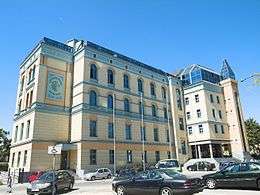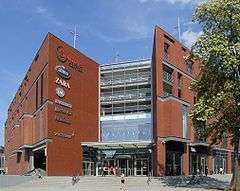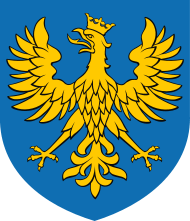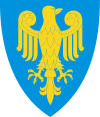Opole
| Opole | |||
|---|---|---|---|
|
Old Town | |||
| |||
 Opole | |||
| Coordinates: 50°40′N 17°56′E / 50.667°N 17.933°E | |||
| Country | Poland | ||
| Voivodeship | Opole | ||
| County | city county | ||
| Town rights | 1217 | ||
| Government | |||
| • Mayor | Arkadiusz Wiśniewski | ||
| Area | |||
| • City | 96.2 km2 (37.1 sq mi) | ||
| Elevation | 176 m (577 ft) | ||
| Population (2009) | |||
| • City | 125,992 | ||
| • Density | 1,300/km2 (3,400/sq mi) | ||
| • Metro | 267,000 | ||
| Time zone | CET (UTC+1) | ||
| • Summer (DST) | CEST (UTC+2) | ||
| Postal code | 45-001 to 45-910 | ||
| Area code(s) | +48 077 | ||
| Car plates | OP | ||
| Website | http://www.opole.pl | ||
Opole [ɔˈpɔlɛ] (German: Oppeln, Silesian German: Uppeln, Silesian: Uopole) is a city located in southern Poland on the Oder River (Odra). With a population of approximately 125,992 (June 2009), it is the capital of the Opole Voivodeship and, also the seat of Opole County.
With it long history dating back to the 9th century, Opole is considered to be one of the oldest towns in Poland. The origins of the first settlement are connected with the town being granted Magdeburg Rights in 1217 by Casimir I of Opole,[1] the great-grandson of Polish Duke Bolesław III Wrymouth. During the Medieval Period and the Renaissance the city was known as a centre of commerce due to its position on the intersection of several main trade routes, which helped to generate steady profits from transit trade. The rapid development of the town was also caused by the establishment of a seat of regency in Opole in 1816. The first railway connection between Opole, Brzeg and Wrocław was opened in 1843 and the first proper manufacturing plants were constructed in 1859, which greatly contributed to the city's regional significance.[2]
During its existence Opole belonged to Poland, Bohemia, Prussia and Germany. Prior to World War II it was located in eastern Germany and was one of the largest centres of Polish minority in the entire country. In 1945, according to Yalta and Potsdam Agreements, the region was assigned to Poland. Many German Upper Silesians and Poles of German ancestry still live in the Opole region; in the city itself, however, ethnic Germans make up less than 3% of the population. It was also the capital of the historical region of Upper Silesia.
Today there are four higher education establishments in the city: The Opole University, Opole University of Technology, a Medical College and the private Higher College of Management and Administration. The National Festival of Polish Song has been held here annually since 1963 and each year new regular events, fairs, shows and competitions take place.[3]
Opole is often referred to as "Polish Venice",[4] because of its picturesque Old Town and a serious of canals and bridges connecting parts of the city.
Name
The name "Opole" likely originated from the medieval Slavic term for a group of settlements.[5]
History
In Medieval Poland
Opole's history begins in the 8th century. At this time, according to the archeological excavations,[6] the first Slavic settlement was founded on the Ostrówek - the northern part of the Pasieka Island in the middle of the Oder river. In the early 10th century it developed into one of the main gróds of the Slavic Opolanie. At the end of the century Silesia became part of Poland and was ruled by the Piast dynasty; the land of the pagan Opolanie was conquered by Duke Mieszko I in 992. From the 11th-12th centuries it was also a castellany. After the death of Duke Władysław II the Exile, Silesia was divided in 1163 between two Piast lines- the Wrocławska line in Lower Silesia and the Opolsko-Raciborska of Upper Silesia. Opole would became a duchy in 1172 and would share much in common with the Duchy of Racibórz, with which it was often combined. In 1281 Upper Silesia was divided further between the heirs of the dukes. The Duchy of Opole was temporarily reestablished in 1290.

In the early 13th century, Duke Casimir I of Opole decided to move the settlement from the Pasieka Island into the right shore of the Oder river (since the 17th century it is the old stream bed of Oder known as Młynówka). All of the inhabitants had to be moved in order to make place for the castle that was eventually built in the place of the old city.[7] Former inhabitants of Ostrówek together with German merchants that immigrated here from the West, received first town rights probably as early as around, 1217 though this date is disputed.[8] Opole received German town law in 1254, which was expanded with Neumarkt law in 1327. Opole developed during the rule of duke Bolko I of Opole. In this time the castle was finally completed and new buildings, including the city walls and the Holy Cross Church, were constructed. Along with most of Silesia, in 1327 the Duchy of Opole came under the sovereignty of the Kingdom of Bohemia, itself part of the Holy Roman Empire. In 1521 the Duchy of Racibórz (Ratibor) was inherited by the Duchy of Opole, by then also known by its German equivalent - Oppeln. The second castle of Opole was probably founded in the 14th century by duke Vladislaus II, though some sources claim that it was originally a wooden stronghold of Opole's castellan dating into 12th century.[9]
In the Habsburg Monarchy
With the death of King Ludvík II of Bohemia at the Battle of Mohács, Silesia was inherited by Ferdinand I, placing Opole under the sovereignty of the Habsburg Monarchy of Austria. The Habsburgs took control of the region in 1532 after the last Piast duke of Opole - Jan II the Good died. In those days the city was still mainly Polish-speaking (around 63%), with other nationalities represented mainly by Germans, Czechs and Jews. The last two dukes of Opole, Nicholas II and Janusz II the Good, did not master the German language.[10]
Beginning in 1532 the Habsburgs pawned the duchy to different rulers including several monarchs of Poland (see Dukes of Opole). With the abdication of King John II Casimir of Poland as the last Duke of Opole in 1668, the region passed to the direct control of the Habsburgs. At the beginning of the 18th century the German population of Opole was estimated at around 20%.[11]
In Prussian Silesia
King Frederick II of Prussia conquered most of Silesia from Austria in 1740 during the Silesian Wars; Prussian control was confirmed in the Peace of Breslau in 1742. During the Prussian rule the ethnic structure of the city began to change. In the early 20th century the number of Polish and bilingual citizens of Opole, according to the official German statistics, varied from only 25% to 31%.[12] From 1816–1945 Opole was the capital of Regierungsbezirk Oppeln within Prussia. The city became part of the German Empire during the unification of Germany in 1871.
After WWI
After the defeat of Imperial Germany in World War I, a plebiscite was held on 20 March 1921 in Opole to determine if the city would be in the Weimar Republic or become part of the Second Polish Republic. 20,816 (94.7%) votes were cast for Germany, 1,098 (5.0%) for Poland, and 70 (0.3%) votes were declared invalid. Voter participation was 95.9%. Results of the plebiscite in the Opole-Land county were different, with 30% of population voting for Poland.
Opole was the administrative seat of the Province of Upper Silesia from 1919–1939. With the defeat of Poland in the Invasion of Poland at the beginning of World War II in 1939, formerly Polish Eastern Upper Silesia was re-added to the Province of Upper Silesia and Opole lost its status as provincial capital to Katowice (renamed Kattowitz).

On 15 February 1941 and 26 February 1941, two deportation transports with 2,003 Jewish men, women and children on board left Vienna Aspang Station for the ghetto which had been set up in Opole. By March 1941, 8,000 Jews were deported to Opole. From May 1941, 800 men capable of work were deployed as forced labourers in Deblin. The "Liquidation" of the Opole ghetto began in the spring 1942. A transport to Belzec extermination camp left on 31 March 1942 and deportations to Sobibor followed in May and October 1942. Of the 2,003 Viennese Jews, only twenty-eight are known to have survived.
In modern Poland
After the end of the Second World War in 1945, Opole was transferred from Germany to Poland according to the Potsdam Conference, and given its original Slavic name of Opole. Opole became part of the Katowice Voivodeship from 1946–1950, after which it became part of the Opole Voivodeship. Unlike other parts of the so-called Recovered Territories, Opole and the surrounding region's indigenous population remained and was not forcibly expelled as elsewhere. Over 1 million Silesians who considered themselves Poles or were treated as such by the authorities due to their language and customs were allowed to stay after they were verified as Poles in a special verification process. It involved declaring Polish nationality and an oath of allegiance to the Polish nation.[13]
In the later years however many of them left to West Germany to flee the communist Eastern Bloc (see Emigration from Poland to Germany after World War II). Today Opole, along with the surrounding region, is known as a centre of the German minority in Poland that recruits mainly from the descendants of the positively verified autochthons. In the city itself however only 2.46% of the inhabitants declared German nationality according to the last national census of 2002.[14]
Historical population
In the early 20th century the amount of Polish and bilingual citizens of Opole, according to the official German statistics, varied from 25 to 31%.[12]

|
|
|
¹ First census of the city
² 8,320 German nationality (93.7%) and 557 Polish nationality (6.3%)
³ 80% German-speaking, 16% Polish-speaking, and 4% bilingual Polish-German-speaking

German minority

Alongside German and Polish, many citizens of Opole-Oppeln before 1945 used a strongly German-influenced Silesian dialect (sometimes called wasserpolnisch or wasserpolak). Because of this, the post-war Polish state administration after the annexation of Silesia in 1945 did not initiate a general expulsion of all former inhabitants of Opole, as was done in Lower Silesia, for instance, where the population almost exclusively spoke the German language. Because they were considered "autochthonous" (Polish), the Wasserpolak-speakers instead received the right to remain in their homeland after declaring themselves as Poles. Some German speakers took advantage of this decision, allowing them to remain in their Oppeln, even when they considered themselves to be of German nationality. The city surroundings currently contain the largest German and Upper Silesian minorities in Poland. However, Opole itself is only 2.46% German.[14] (See also Germans of Poland.)
Main sights

Opole hosts the annual National Festival of Polish Song. The city is also known for its 10th-century Church of St. Adalbert and the 14th-century Church of the Holy Cross. There is a zoo, the Ogród Zoologiczny w Opolu.
Structures and buildings
- Piast tower on the island (only part that remained of Piast castle)
- a 14th-century Franciscan church, a Piast mausoleum
- a 19th-century Town Hall
- the Church of our Lady of Sorrows and St. Adalbert (Kościół Matki Boskiej Bolesnej i św. Wojciecha)
- the 14th-century Holy Cross Cathedral (Bazylika katedralna Podwyższenia Krzyża Świętego)
- The art nouveau Penny Bridge (Most Groszowy), currently named Green Bridge (Zielony Mostek)
- Opole Main Station, an eclectic building from early 20th century.
Museums
- Diocesan Museum (Muzeum Diecezjalne)
- Opole Regional Museum (Muzeum Śląska Opolskiego)
- Opole Village Museum (Muzeum Wsi Opolskiej)
Cemeteries
- The Jewish Cemetery in Opole was established in 1822, and it is a peculiar pantheon of the Jews of Opole.[15][16]
Geography
Opole is one of the warmest cities in Poland. The national all time heat record was measured in Prószków, near Opole.
| Climate data for Opole | |||||||||||||
|---|---|---|---|---|---|---|---|---|---|---|---|---|---|
| Month | Jan | Feb | Mar | Apr | May | Jun | Jul | Aug | Sep | Oct | Nov | Dec | Year |
| Record high °C (°F) | 15.8 (60.4) |
19.3 (66.7) |
25.0 (77) |
28.2 (82.8) |
32.6 (90.7) |
35.5 (95.9) |
38.0 (100.4) |
39.0 (102.2) |
35.4 (95.7) |
26.2 (79.2) |
21.9 (71.4) |
16.1 (61) |
39.0 (102.2) |
| Average high °C (°F) | 1.9 (35.4) |
3.7 (38.7) |
8.4 (47.1) |
15.7 (60.3) |
20.0 (68) |
23.1 (73.6) |
25.6 (78.1) |
24.7 (76.5) |
19.9 (67.8) |
14.0 (57.2) |
8.5 (47.3) |
2.8 (37) |
14.0 (57.2) |
| Daily mean °C (°F) | −0.5 (31.1) |
0.6 (33.1) |
4.2 (39.6) |
10.1 (50.2) |
14.4 (57.9) |
17.7 (63.9) |
19.9 (67.8) |
19.1 (66.4) |
14.8 (58.6) |
10.0 (50) |
5.6 (42.1) |
0.6 (33.1) |
9.7 (49.5) |
| Average low °C (°F) | −2.9 (26.8) |
−2.3 (27.9) |
0.0 (32) |
4.4 (39.9) |
8.9 (48) |
12.3 (54.1) |
14.4 (57.9) |
13.5 (56.3) |
9.5 (49.1) |
5.9 (42.6) |
2.8 (37) |
−1.6 (29.1) |
5.4 (41.7) |
| Record low °C (°F) | −25.2 (−13.4) |
−22.9 (−9.2) |
−15.6 (3.9) |
−6.8 (19.8) |
−4.4 (24.1) |
1.8 (35.2) |
5.0 (41) |
1.0 (33.8) |
−1.5 (29.3) |
−6.7 (19.9) |
−12.9 (8.8) |
−22.5 (−8.5) |
−25.2 (−13.4) |
| Average precipitation mm (inches) | 34 (1.34) |
29 (1.14) |
32 (1.26) |
29 (1.14) |
59 (2.32) |
66 (2.6) |
73 (2.87) |
46 (1.81) |
47 (1.85) |
29 (1.14) |
31 (1.22) |
34 (1.34) |
494 (19.45) |
| Average precipitation days | 16 | 13 | 14 | 11 | 13 | 12 | 13 | 9 | 11 | 11 | 13 | 15 | 151 |
| Average relative humidity (%) | 83 | 81 | 76 | 71 | 72 | 73 | 72 | 74 | 78 | 79 | 83 | 84 | 77 |
| Mean monthly sunshine hours | 48 | 70 | 127 | 191 | 225 | 224 | 238 | 221 | 151 | 108 | 56 | 41 | 1,698 |
| Source #1: | |||||||||||||
| Source #2: http://climatebase.ru/station/12530/?lang=en | |||||||||||||
Education

- state-run universities and colleges:
- privately run colleges:
- Management and Administration College in Opole (Wyższa Szkoła Zarządzania i Administracji w Opolu)
- Bogdan Jański Academy (Szkoła Wyższa im. Bogdana Jańskiego)
- WSB Universities - WSB University in Wrocław,[17] departments of Economics
Politics

Members of Parliament (Sejm) elected from Opole constituency
- Danuta Jazłowiecka, PO
- Tadeusz Jarmuziewicz, PO
- Ryszard Knosala, PO
- Leszek Korzeniowski, PO
- Sławomir Kłosowski, PiS
- Teresa Ceglecka-Zielonka, PiS
- Mieczysław Walkiewicz, PiS
- Henryk Kroll, German minority
- Ryszard Galla, German minority
- Józef Stępkowski, Samoobrona
- Sandra Lewandowska, Samoobrona
- Tomasz Garbowski, SLD
- Marek Kawa, LPR
Famous residents

- Władysław Opolczyk, count palatine of Poland 1378
- Edwin von Drenkmann (1826–1904), famous German lawyer
- Paul Kleinert (1837–1920), German theologian
- Emin Pasha (born Eduard Schnitzer) (1840–1892), explorer and governor of Africa
- Jan Kasprowicz (1860–1926), poet
- Ferdinand von Prondzynski, 19th-century Prussian general, whose direct descendant Ferdinand von Prondzynski is Principal and Vice-Chancellor of Robert Gordon University in Aberdeen, Scotland
- Bronisław Koraszewski (1863–1924), Polish activist, founder of Gazeta Opolska
- Oscar Slater (1872–1948), German/Scottish victim of miscarriage of justice
- Jakub Kania (1872–1957), Polish poet and writer, soldier in the Silesian Uprisings
- Leo Baeck (1873–1956), rabbi
- Szymon Koszyk (1891–1972), reporter, teacher and Polish activist from Opole
- Karol Musioł (1902–1983), president of Opole, founder of the National Festival of Polish Song in Opole
- Joachim Prinz (1902, Bierdzan – 1988), rabbi, born here
- Edmund Osmańczyk (1913–1989), reporter, politician (6 times elected to the sejm and once to the senat)
- Rochus Misch (1917-2013), communications' chief of the Reichskanzlei and member of the Leibstandarte-SS Adolf Hitler
- Jerzy Grotowski (1933–1999), theater director
- Jerzy Buzek (born 1940), academic and politician, President of the European Parliament, former Prime Minister of Poland
- Chester Marcol (born 1949), American football placekicker for the Green Bay Packers
- Bolesław Polnar (born 1952), graphic artist and painter
- Andrzej Jerzy Lech (born 1955), artist and photographer
- Anna Brzezińska (born 1971), fantasy writer
- Miroslav Klose (born 1978), football player (playing in the German national football team)
- Krzysztof Szramiak (born 1984), Polish weightlifter
- Marcin Pontus (born 1985), football player
- Karolina Wydra (born 1981), actress
Economy


Food sector:
Metal:
- Polaris Industries
- Energomet
- Heerema
- Kamex
- Movie Bird
- Remak
- APC Prestmet
- Tower Automotive
BPO:
- Capgemini
- opta data Gruppe
- Future Processing
IT
Trade
- Solaris Center
- CH Karolinka
- Galeria Tesco
- Galeria Turawa
- Galeria Opolanin in Opole in ul.Ozimska-/-in Ozimska street,plac teatralny,theater-place,
- Galeria Piastowska
- Galeria Centrum
- CH Real
- CH Kaskada
International relations
Twin towns - Sister cities
Gallery
- Green Bridge
 The Church of the Holy Trinity
The Church of the Holy Trinity The Młynówka Canal (Little Venice)
The Młynówka Canal (Little Venice) Old Town
Old Town
References
- The Columbia Electronic Encyclopedia. "Opole". Columbia University Press. Accessed June 4, 2006.
- ↑ http://www.mapofpoland.net/Opole,description.html
- ↑ http://www.sztetl.org.pl/en/article/opole/3,local-history/
- ↑ http://www.poland.travel/en-gb/cities/opole-history-and-song-festivals
- ↑ http://studiowac.pl/2235/studia-w-opolu-polska-wenecja-moze-zaoferowac-wam-nie-tylko-wspaniale-widoki-ale-takze-cudowna-atmosfere/
- ↑ Opole, Słownik geograficzny Królestwa Polskiego i innych krajów słowiańskich, Tom VII, nakł. Filipa Sulimierskiego i Władysława Walewskiego, 1880-1914
- ↑ B. Gediga, Początki i rozwój wczesnośredniowiecznego ośrodka miejskiego na Ostrówku w Opolu, Slavia Antiqua t. 16, Wrocław 1970.
- ↑ W. Dziewulski, F. Hawranek, Opole - Monografia miasta, Instytut Śląski Opole 1975, p. 57.
- ↑ This opinion is shared i.e. by W. Dziewulski, F. Hawranek, Opole - Monografia miasta, Instytut Śląski Opole 1975, p. 57 and G. A. Stenzel, Geschichte Schlesiens, T1. 1, Breslau 1853, p. 41. The opposite opinion is presented i.e. by K. Buczek, Targi i miasta na prawie polskim (okres wczesnośredniowieczny), Wrocław 1964, p. 114.
- ↑ W. Dziewulski, F. Hawranek, Opole - Monografia miasta, Instytut Śląski Opole 1975, pp. 58-60.
- ↑ W. Dziewulski, F. Hawranek, Opole - Monografia miasta, Instytut Śląski Opole 1975, p.78.
- ↑ W. Dziewulski, F. Hawranek, Opole - Monografia miasta, Instytut Śląski Opole 1975, p.159.
- 1 2 W. Dziewulski, F. Hawranek, Opole - Monografia miasta, Instytut Śląski Opole 1975, p. 263-268".
- ↑ The Expulsion of 'German' Communities from Eastern Europe at the end of the Second World War, Steffen Prauser and Arfon Rees, European University Institute, Florense. HEC No. 2004/1. p.28
- 1 2 German minority in Poland on the Ministry of Interior and Administration webpage
- ↑ "JEWISH CEMETERY IN OPOLE (GRANICZNA STREET)". Muzeum Historii Żydów Polskich. Retrieved 20 October 2012.
- ↑ "OPOLE: Opolskie". International Jewish Cemetery Project. Retrieved 20 October 2012.
- ↑ WSB University in Wrocław - WSB Universities
- 1 2 3 4 5 6 7 8 9 10 11 12 13 "Miasta Partnerskie Opola". Urzad Miasta Opola (in Polish). Retrieved 2013-08-01.
- ↑ Офіційний сайт міста Івано-Франківська. mvk.if.ua (in Ukrainian). Retrieved 7 March 2010.
- ↑ "Die Partnerstädte der Landeshauptstadt Potsdam". www.potsdam.de (in German). Retrieved 24 June 2010.
- ↑ Bozsoki, Agnes. "Partnervárosok Névsora Partner és Testvérvárosok Névsora" [Partner and Twin Cities List]. City of Székesfehérvár (in Hungarian). Archived from the original on 2012-12-08. Retrieved 2013-08-05.
External links
| Wikivoyage has a travel guide for Opole. |
| Wikimedia Commons has media related to Opole. |
- Opole - Official Tourist Information
- Municipal website
- Urban development of Opole in the Historical-Topographical Atlas of Silesian Towns
- Jewish Community in Opole on Virtual Shtetl
- Webcam showing Krakowska Street in Opole (Polish)
- Culture: Amfiteart Opole
- Culture: KFPP Opole
Coordinates: 50°40′N 17°56′E / 50.667°N 17.933°E




